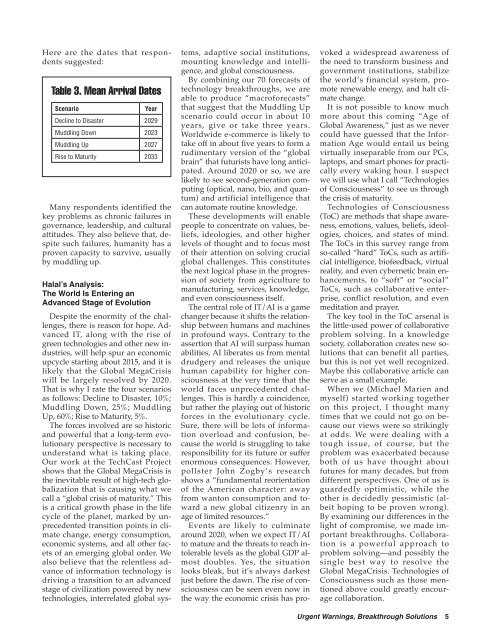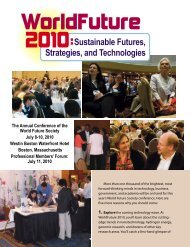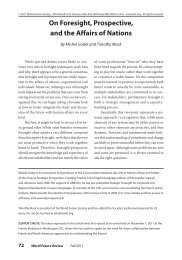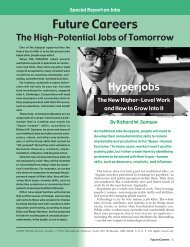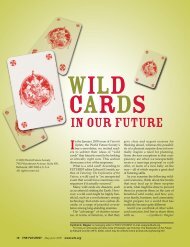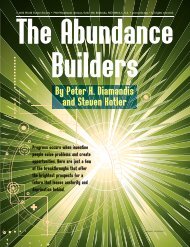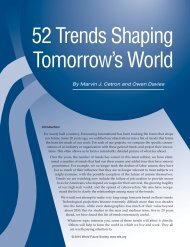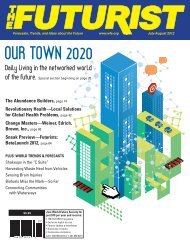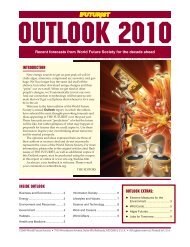Urgent Warnings, Breakthrough Solutions, Second Edition
Urgent Warnings, Breakthrough Solutions, Second Edition
Urgent Warnings, Breakthrough Solutions, Second Edition
Create successful ePaper yourself
Turn your PDF publications into a flip-book with our unique Google optimized e-Paper software.
Here are the dates that respondents<br />
suggested:<br />
Table 3. Mean Arrival Dates<br />
Scenario<br />
Year<br />
Decline to Disaster 2029<br />
Muddling Down 2023<br />
Muddling Up 2027<br />
Rise to Maturity 2033<br />
Many respondents identified the<br />
key problems as chronic failures in<br />
governance, leadership, and cultural<br />
attitudes. They also believe that, despite<br />
such failures, humanity has a<br />
proven capacity to survive, usually<br />
by muddling up.<br />
Halal’s Analysis:<br />
The World Is Entering an<br />
Advanced Stage of Evolution<br />
Despite the enormity of the challenges,<br />
there is reason for hope. Advanced<br />
IT, along with the rise of<br />
green technologies and other new industries,<br />
will help spur an economic<br />
upcycle starting about 2015, and it is<br />
likely that the Global MegaCrisis<br />
will be largely resolved by 2020.<br />
That is why I rate the four scenarios<br />
as follows: Decline to Disaster, 10%;<br />
Muddling Down, 25%; Muddling<br />
Up, 60%; Rise to Maturity, 5%.<br />
The forces involved are so historic<br />
and powerful that a long-term evolutionary<br />
perspective is necessary to<br />
understand what is taking place.<br />
Our work at the TechCast Project<br />
shows that the Global MegaCrisis is<br />
the inevitable result of high-tech globalization<br />
that is causing what we<br />
call a “global crisis of maturity.” This<br />
is a critical growth phase in the life<br />
cycle of the planet, marked by unprecedented<br />
transition points in climate<br />
change, energy consumption,<br />
economic systems, and all other facets<br />
of an emerging global order. We<br />
also believe that the relentless advance<br />
of information technology is<br />
driving a transition to an advanced<br />
stage of civilization powered by new<br />
technologies, interrelated global sys-<br />
tems, adaptive social institutions,<br />
mounting knowledge and intelligence,<br />
and global consciousness.<br />
By combining our 70 forecasts of<br />
technology breakthroughs, we are<br />
able to produce “macroforecasts”<br />
that suggest that the Muddling Up<br />
scenario could occur in about 10<br />
years, give or take three years.<br />
Worldwide e-commerce is likely to<br />
take off in about five years to form a<br />
rudimentary version of the “global<br />
brain” that futurists have long anticipated.<br />
Around 2020 or so, we are<br />
likely to see second-generation computing<br />
(optical, nano, bio, and quantum)<br />
and artificial intelligence that<br />
can automate routine knowledge.<br />
These developments will enable<br />
people to concentrate on values, beliefs,<br />
ideologies, and other higher<br />
levels of thought and to focus most<br />
of their attention on solving crucial<br />
global challenges. This constitutes<br />
the next logical phase in the progression<br />
of society from agriculture to<br />
manufacturing, services, knowledge,<br />
and even consciousness itself.<br />
The central role of IT/AI is a game<br />
changer because it shifts the relationship<br />
between humans and machines<br />
in profound ways. Contrary to the<br />
assertion that AI will surpass human<br />
abilities, AI liberates us from mental<br />
drudgery and releases the unique<br />
human capability for higher consciousness<br />
at the very time that the<br />
world faces unprecedented challenges.<br />
This is hardly a coincidence,<br />
but rather the playing out of historic<br />
forces in the evolutionary cycle.<br />
Sure, there will be lots of information<br />
overload and confusion, because<br />
the world is struggling to take<br />
responsibility for its future or suffer<br />
enormous consequences. However,<br />
pollster John Zogby’s research<br />
shows a “fundamental reorientation<br />
of the American character: away<br />
from wanton consumption and toward<br />
a new global citizenry in an<br />
age of limited resources.”<br />
Events are likely to culminate<br />
around 2020, when we expect IT/AI<br />
to mature and the threats to reach intolerable<br />
levels as the global GDP almost<br />
doubles. Yes, the situation<br />
looks bleak, but it’s always darkest<br />
just before the dawn. The rise of consciousness<br />
can be seen even now in<br />
the way the economic crisis has pro-<br />
voked a widespread awareness of<br />
the need to transform business and<br />
government institutions, stabilize<br />
the world’s financial system, promote<br />
renewable energy, and halt climate<br />
change.<br />
It is not possible to know much<br />
more about this coming “Age of<br />
Global Awareness,” just as we never<br />
could have guessed that the Information<br />
Age would entail us being<br />
virtually inseparable from our PCs,<br />
laptops, and smart phones for practically<br />
every waking hour. I suspect<br />
we will use what I call “Technologies<br />
of Consciousness” to see us through<br />
the crisis of maturity.<br />
Technologies of Consciousness<br />
(ToC) are methods that shape awareness,<br />
emotions, values, beliefs, ideologies,<br />
choices, and states of mind.<br />
The ToCs in this survey range from<br />
so-called “hard” ToCs, such as artificial<br />
intelligence, biofeedback, virtual<br />
reality, and even cybernetic brain enhancements,<br />
to “soft” or “social”<br />
ToCs, such as collaborative enterprise,<br />
conflict resolution, and even<br />
meditation and prayer.<br />
The key tool in the ToC arsenal is<br />
the little-used power of collaborative<br />
problem solving. In a knowledge<br />
society, collaboration creates new solutions<br />
that can benefit all parties,<br />
but this is not yet well recognized.<br />
Maybe this collaborative article can<br />
serve as a small example.<br />
When we (Michael Marien and<br />
myself) started working together<br />
on this project, I thought many<br />
times that we could not go on because<br />
our views were so strikingly<br />
at odds. We were dealing with a<br />
tough issue, of course, but the<br />
problem was exacerbated because<br />
both of us have thought about<br />
futures for many decades, but from<br />
different perspectives. One of us is<br />
guardedly optimistic, while the<br />
other is decidedly pessimistic (albeit<br />
hoping to be proven wrong).<br />
By examining our differences in the<br />
light of compromise, we made important<br />
breakthroughs. Collaboration<br />
is a powerful approach to<br />
problem solving—and possibly the<br />
single best way to resolve the<br />
Global MegaCrisis. Technologies of<br />
Consciousness such as those mentioned<br />
above could greatly encourage<br />
collaboration.<br />
<strong>Urgent</strong> <strong>Warnings</strong>, <strong>Breakthrough</strong> <strong>Solutions</strong> 5


